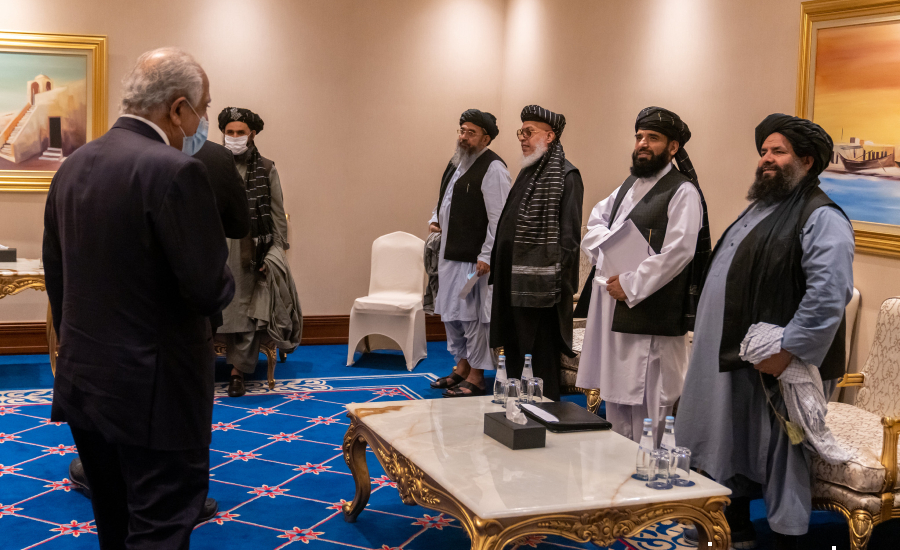Thinking Long Term About the Future of Afghanistan
The presence of international terrorist groups may grow in the months and years ahead, but there are steps the United States can take to mitigate the risks.

Published by The Lawfare Institute
in Cooperation With

Editor’s Note: With U.S. forces gone and the Taliban in control, will Afghanistan again become a hub for international terrorists? President Biden has bet heavily that the problem will be manageable at worst. Caitlin O’Hara and Colin P. Clarke of The Soufan Center, however, argue that Afghanistan is already home to an array of dangerous actors and that this threat is likely to grow in the absence of U.S. forces.
Daniel Byman
***
With the Taliban back in power and a witches’ brew of jihadist groups active in the country—including al-Qaeda and the Islamic State in Khorasan (IS-K)—security concerns remain in Afghanistan. The United States’ ability to gather intelligence and act on these threats will be greatly diminished by the U.S. withdrawal, giving it little insight into how these groups may take advantage of Taliban rule to draw in jihadists from around the world to reconstitute themselves. The remaining options are less than ideal, but keeping a dialogue open with the Taliban and continuing to provide some aid to Afghanistan could allow cooperation on the issues that matter most to Washington.
Security Implications of the U.S. Troop Withdrawal
In its 2021 Annual Threat Assessment, the Office of the Director of National Intelligence suggested that al-Qaeda still seeks to conduct attacks inside the United States, but that “sustained U.S. and allied [counterterrorism] pressure has broadly degraded their capability to do so.” This capability, however, is likely to grow now that the Taliban are back in charge. With U.S. intelligence capabilities attenuated following the U.S. troop withdrawal and the collapse of America’s Afghan partner—especially the ability to find, fix and finish—groups like al-Qaeda and IS-K could grow stronger without much forewarning. Ambassador Nathan Sales, former coordinator for counterterrorism at the State Department, believes al-Qaeda could potentially reconstitute its external operations capabilities within six months. In 2015, the United States discovered an al-Qaeda training camp in Kandahar with hundreds of militants.
With the closure of Bagram Airbase and the shuttering of the Afghan National Directorate of Security, the United States will be hard pressed to acquire and act on the type of intelligence that has fueled counterterrorism operations over the past two decades. The United States will face challenges recruiting human sources remotely while the intelligence community operates from outside of Afghanistan, in addition to the difficulties of attempting to recover from the collapse of existing liaison relationships.
To reduce the risk of surprises from Afghanistan, the CIA will be focused on “tracking the development of terrorist groups determined to attack the United States.” With U.S. leaders expressing diminished enthusiasm for spending in Afghanistan following the completion of the military withdrawal, remaining financial resources are likely to focus more narrowly on groups that pose an immediate threat to the United States. Given the Afghanistan-Pakistan region’s alphabet soup of constantly evolving jihadist groups, it will be difficult to identify who’s who as conditions on the ground evolve.
But even if al-Qaeda does regenerate, there is no guarantee it will immediately revert to its pre-9/11 modus operandi focused on launching attacks against the United States. After all, as several experts have pointed out, the Taliban have major incentives to prevent al-Qaeda from using Afghanistan as a base to attack the West. The Taliban are seeking international legitimacy, and the quickest way to close that door is to allow any group on Afghan soil to launch terrorist attacks against the West. With good relations between al-Qaeda and the Taliban, the latter may successfully convince the former to focus on local and regional issues, helping the Taliban to shore up and extend their influence throughout South Asia over time.
That still leaves IS-K, a group previously linked to an international terrorist plot against U.S. and NATO bases in Germany, as a significant threat. There are serious doubts about whether the Taliban, overwhelmed and stretched thin by the challenge of attempting to govern a war-ravaged nation, will be able to prevent IS-K or other rogue groups from operating on Afghan soil. In August 2019, U.S. military officials in Afghanistan described IS-K as capable of both inspiring and directing attacks in Western countries, including the United States. But IS-K has been weakened over the past several years and is more concerned in the immediate term with rebuilding its organization and growing its ranks. Over time, IS-K may seek targets in the South Asia region and beyond, but first it needs to survive its rivalry with the Taliban and its al-Qaeda and Haqqani Network allies.
Will Afghanistan Reemerge as a Global Terrorist Hub?
Whether or not Afghanistan reemerges as a terrorist hub in the future will depend in part on the role played by foreign fighters. Some terrorism experts have already identified calls by jihadists for their fighters to flock to Afghanistan from Syria and countries in Central and Southeast Asia. There is little doubt that the global jihadist movement has been energized by the Taliban’s victory. Jihadist groups such as Hay’at Tahrir al-Sham in Syria and Tehrik-e-Taliban in Pakistan have praised the Taliban as a model to emulate. In West Africa, al-Qaeda-linked Jama’at Nusrat ul-Islam wa al-Muslimin praised the organization’s “two decades of patience” and suggested that a similar strategy would help its fighters conquer Mali and other countries in the Sahel. The Taliban’s victory, with al-Qaeda as a beneficiary, will serve as proof of concept for jihadist groups that a gradualist approach can be effective.
Foreign fighters could mobilize for Afghanistan in several ways. First, both al-Qaeda and the Islamic State maintain global affiliates that could seek to dispatch operatives to Afghanistan to reinforce their groups’ presence in South Asia. Second, an unknown number of Islamic State foreign fighters are unaccounted for in the Middle East, with many believed to be hiding out in third-party countries waiting for an opportunity to regroup and find a base from which to launch attacks. Third, there are what terrorism expert Daniel Byman has labeled “professional jihadis,” foreign fighters who are not necessarily tied to a specific struggle but who travel to various conflict zones and civil wars “looking for jihad.”
Given the presence of as many as 10,000 fighters from Xinjiang, the Caucasus, Central Asia and Pakistan already in Afghanistan, a Taliban-al-Qaeda alliance could destabilize large swaths of the region. Some of these fighters are just there to help the Taliban win and consolidate power, but others may join al-Qaeda or IS-K. Prison breaks during the Taliban’s storming of the country in August also led to the release of dangerous jihadists—including former Islamic State and al-Qaeda militants—who will be eager to rejoin cadres of violent extremist organizations. There is also the possibility that the Taliban splinter into regional offshoots, further complicating the situation in Afghanistan and leading to a protracted civil war.
What Should the United States Do Next?
Regardless of the way the Taliban eventually choose to govern, the reality remains that they will inherit a war-torn country faced with more than 3.5 million internally displaced Afghans, severe economic insecurity, deepening climate and hunger crises, and a resurgent IS-K. These converging stressors will likely serve as threat multipliers that will only exacerbate Afghanistan’s already precarious security situation. While the United States clearly has little appetite for nation-building in Afghanistan, it still has a vested interest in containing terrorist organizations and extremist activities within the country.
In the wake of the U.S. troop withdrawal, Washington’s leverage in Afghanistan is considerably diminished, which means it will likely need to rely on other states active in the region—including Russia, China, Iran, Pakistan and India—to serve as moderating influences on the Taliban and to cooperate on information sharing and counterterrorism operations. China is already stepping up to fill the power vacuum left by the U.S. departure, and with its own economic and security interests in mind, it might become a valuable partner in curbing certain terrorist threats. Authoritarian states, however, make for unreliable bedfellows, and U.S. interests might be better served by reengaging with Afghanistan and the surrounding region to recapture some of its lost or forsaken leverage. The United States has a range of powerful instruments available for use—diplomacy, development assistance, economic trade and intelligence gathering—that could help it maintain a stabilizing presence in Afghanistan (and a region with three nuclear powers) while avoiding a military entanglement.
Though cooperation will be a bitter pill to swallow, the United States and the Taliban share some common goals—including feeding the population, fighting IS-K and establishing a functioning economy—which will be incredibly difficult to achieve without some form of partnership. Cooperation with the Taliban, however unsavory, is not unprecedented. American diplomats negotiated security and peace terms with Taliban leadership, culminating in the 2020 Doha Agreement, and military commanders shared intelligence with the Taliban to secure Kabul’s airport and facilitate evacuations in August. Gen. Mark Milley, chairman of the Joint Chiefs of Staff, has even floated the possibility of coordinating with the Taliban to target extremist groups operating in Afghanistan. This type of cooperation will likely continue to be transactional in nature, tied to specific targets or concessions, and will almost certainly vary depending on how reasonable the Taliban’s governing style ends up being.
Though working with the Taliban is unpalatable, there are many reasons the United States should try to prevent Afghanistan from devolving into a failed state. Investing in the country could allow Western nations leverage as they push the Taliban to form an inclusive government and guarantee women’s rights in exchange for financial support and legitimacy, and it could ameliorate some of the poverty that drives desperate individuals to join extremist organizations. But perhaps most importantly, it could help sustain a constructive relationship on the primary issue that brought U.S. troops to Afghanistan two decades ago. Working with the Taliban could provide the opportunity and environment conducive to at least some of the counterintelligence operations necessary to keep dangerous terrorist organizations at bay.





